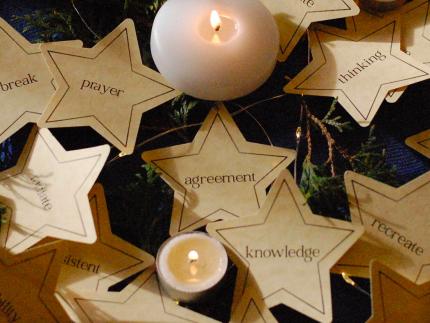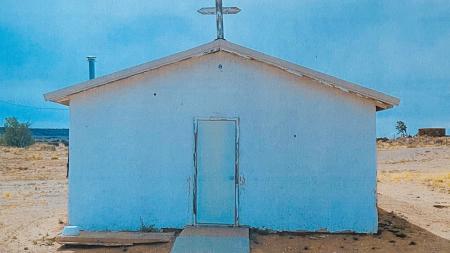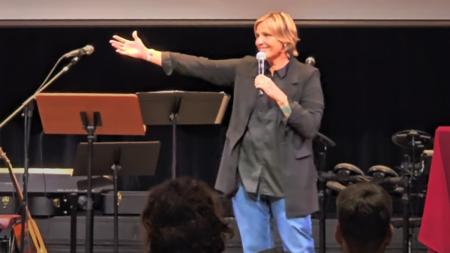Pandemic Worship Changes Worth Keeping

During the past few years, almost every project funded by the Calvin Institute of Christian Worship’s Vital Worship Grants program has been changed by the pandemic.
Many people left churches—some because they thought in-person worship was too restrictive or no longer safe. Others said virtual worship was not satisfying. Meanwhile, countless congregations found that being forced into virtual worship opened opportunities to be more flexible and creative, involve more people, highlight justice issues, and reach people far beyond their church’s geographic boundaries.
Vital Worship grant recipients and other worshiping communities often said they experienced these changes as blessings that deepened worship and a sense of community even while not being able to gather for in-person worship—so much so that many church leaders committed to maintaining a virtual presence even after most worshipers returned to indoor services.
“We began to identify as people worshiping as Grace Baptist Church rather than at Grace Baptist Church,” says Suzanne L. Vinson, who led the Richmond, Va., congregation’s Vital Worship Grant program to cocreate liturgical language with all ages, enliven worship, and connect with each other and God.
She and other church leaders highlighted five worship changes worth keeping: creating tangible displays, kits, and outdoor contacts; inviting people to contribute words and images; using outdoor assets; involving youth; and archiving digital creations.
Creating Tangible Displays, Kits, and Outdoor Contacts
Architects Lynnette Postuma and Karen Zwart Hielema planned a Vital Worship Grant project at First Christian Reformed Church of Toronto, Ont. Their Seasons of Being project involved all ages in learning how colors express emotion and how liturgical seasons help people place themselves in God's big story.
When pandemic restrictions prevented the congregation from worshiping in the church building, Postuma and Zwart Hielema designed Seasons of Being kits that people could use at home. Each kit included a set of 10 plexiglass tiles in the colors of the liturgical seasons and a base of reclaimed wood cut with grooves to hold the tiles. (The congregation also created a permanent installation in the church sanctuary.)
"The communications committee helped us distribute the kits,” Zwart Hielema said. “Because we have a value of connecting, we did porch visits while dropping off kits. Some people even delivered the kits by bicycle."
Historic First Church in Windsor, Conn., a United Church of Christ congregation, created a new tradition of receiving Epiphany star gifts. Senior pastor Nicole S. Grant Yonkman mailed stars cut from recycled Christmas cards with a special word or phrase and Scripture reference written on the back.
“Our star gifts give us a chance to reflect on how God encourages us, gives us light for our journey, and leads us to something we might not have imagined,” said Laurel Pepin, a photographer who helped lead the church’s Vital Worship Grant project.
Grace Baptist Church in Richmond, Va., displayed an outdoor sign saying, “You are loved. You are not alone. God is with us.” Participants repeated this message on artful yard signs and “backpack blessing buttons” distributed at a Blessing of the Learners and Church Recovenanting drive-through event, with back-to-school learning kits for children and youth and “mug hugs” for educators.
Organizers also distributed cardmaking kits before leading a Zoom class on making cards.
“The class bolstered those who attended,” Vinson said. “They reported ‘creativity I didn’t know I had . . . relaxation, connection, and a deeper sense of being the church together.’”
On World Communion Sunday, the church also hosted drive-through communion and outdoor small-group circles of support. And in December their Jazz Advent online concert crossed geographic boundaries to feature musicians from several states.
Contributing Words and Images
The grant recipients in Toronto, Windsor, and Richmond found ways for virtual worshipers to contribute words and images so that worshipers felt like participants, not viewers.
At First CRC of Toronto, grant project directors invited people to photograph and upload scenes of how they arranged their Seasons of Being tiles, and then, to maintain interest, created a 15-minute photo challenge during Ordinary Time.
“We asked people to add found objects to their display, take photos, and upload them,” Postuma said. “The photos were used during mini-reflections in virtual worship. Contributing images helped people feel connected, in part by offering glimpses of their homes.”
First Church in Windsor has gained many virtual worshipers during the pandemic, said Pepin. “Some people, especially [those] with underlying health issues, may never return to in-person worship,” she said. “We find that using videos can be a bridge between in-person and online worshipers.”
For example, she made short videos of people who volunteered to explain what they’d learned from reflecting on Scripture and their Epiphany star gift words, such as “completion,” “deliver,” “do not fear,” “glorify,” “healing,” “hope,” “love,” “radiance,” and “rejoice.” The videos were also used during worship.
Each September, the Windsor congregation celebrates Water Communion Sunday, a unity-in-diversity ritual marking summer’s end and a return to church programs. People are asked to collect small bottles of water over the summer and bring them to church to be combined, blessed, boiled, and used for baptisms. Now they also ask virtual and onsite worshipers to contribute water-collecting photos with six-word captions. These are now included in a slideshow on Water Communion Sunday and again on Baptism of Christ Sunday in Epiphany.
At Grace Baptist Church, Vinson invited participants of all ages to cocreate liturgical language used in the congregation’s calls to worship and stewardship, prayers, psalm paraphrases, songs, and more. Youth and adults also contributed their recorded voices for lectionary readings and liturgical language. “We try to use all members' voices in worship because we believe all are ministers, and we want everyone to have a voice,” she explained.
Using Outdoor Assets
As COVID-19 restrictions eased to allow larger outdoor gatherings, many churches held their first-ever outdoor worship services. They noticed that hearing birds and rustling leaves, smelling flowers, and feeling sunlit breezes helped them more deeply experience being a part of God’s created world.
They also began considering worship possibilities in previously overlooked portions of exterior church property. First African Methodist Episcopal Church, a Vital Worship Grant recipient in Grand Rapids, Mich., turned its parking lot into worship space. People could experience worship through open car windows or sit on chairs in the parking lot.
Another Grand Rapids congregation, Church of the Servant CRC, began using the cement patio and lawn of its courtyard area for Sunday worship, funerals, baptisms, and (with portable heaters) autumn outdoor hymnsings. They moved playground equipment into the courtyard so that families could keep an eye on children while drinking coffee outdoors with people of many ages. The old playground became home to a firepit and seating areas used for youth activities and for Christmas caroling. The congregation’s creation-care committee also improved the nature trail around the 20-acre campus. During Lent they set up large wooden crosses for guided prayer walks.
St. Elizabeth Episcopal Church in Dahlonega, Ga., had planned to use its Vital Worship Grant to develop a monthly Sunday-evening Celtic worship service. Dahlonega, a college town in the Blue Ridge Mountain foothills, has many local musicians who play Celtic, bluegrass, and old-time Appalachian music. Project director Lara Lowman said she had hoped the nontraditional worship service would draw college students, retirees, church members, and others indoors to connect through contemplative worship.
Continued pandemic restrictions kiboshed plans for indoor Celtic worship, however. Lowman explained in their grant poster and grant reports that “when outdoor worship became our best option, we found a flat space, brought in plants, candles, small tables, a cross and altar, and transformed it into a lovely worship experience that we now use each month, weather permitting. The environment complements the Celtic vespers service beautifully, which we might never have known had it not been forced on us.”
Involving Youth
Creating visual art, videos, language, and more for virtual and hybrid worship opens options for youth to participate. At First CRC in Toronto, church youth helped assemble 125 at-home kits for their Seasons of Being grant project. And at Grace Baptist Church in Richmond, Vinson used youth-group Facebook chats to gather ideas and language for Advent liturgies.
For almost four hundred years, First Church in Windsor has increasingly gotten involved in justice issues, said Pepin. Social justice, based on Christ’s call to love one another, is one of the congregation’s six core values. Youth participated in living this out through transformational worship during Epiphany by reading portions of Martin Luther King, Jr.’s “Letter from Birmingham Jail.” The compiled video became part of a virtual Sunday worship service held during Epiphany 2021. Some youth in the congregation also helped to create videos for worship.
In Grand Rapids, First African Methodist Episcopal’s grant project focused on prayer, servant leadership, and praise and worship. Project director Lisa B. Taylor reports that it was difficult moving from an in-person worship service to digital or conference-call platforms. “The majority of our church members are 65 years or older and technologically challenged,” she wrote.
But the older members’ digital struggles presented an opportunity for youth to show servant leadership. “Our youth and millennial members have untapped spiritual gifts and talents that they are waiting to use,” Taylor said. Some helped older members master conference calls and connect to virtual worship. Other youth and millennials used Zoom and Facebook Live to welcome people to worship, teach church school, lead book studies, and participate in prayer conferences.
Archiving Digital Creations
When congregations put effort into creating elements for virtual, hybrid, and in-person worship, it makes sense to archive the elements.
"First Church in Windsor decided never to repeat a visual installation,” Pepin said. “You can't repeat the surprise and awe of the first moments of the experience.” Yet the church archives many of its short videos on its Facebook page and YouTube channel.
"When we returned to in-person worship, we realized we could be relegated again at any time to online worship and that we were reaching possibly more people online than in person anyway. Our short, artistic videos connected to people online.
We made them shareable because online worship has become a first step to invite people into deeper connection, perhaps by coming to in-person worship or events," Grant Yonkman added.
At Grace Baptist the staff plans worship cooperatively, so they help each other remember what the congregation has already created.“We have a Google Docs folder with the scanned poetry, literature, hymns, and congregation-written material (hymnkus, song and psalm paraphrases, etc.) that we've used in worship, [and] we archive services on our YouTube channel,” said Vinson.
“Eventually we hope to create a resource library on our church website with short clips of prayers, lectionary readings, videos, congregation-created material, and more. We have found that Scripture and liturgy recorded by those who have died is so meaningful and treasured. What a gift to have their presence remain with us in these ways—these beautiful souls whom we love and miss and who are now in the great cloud of witnesses.”
This story first appeared on the Calvin Institute of Christian Worship website and is republished with permission.


